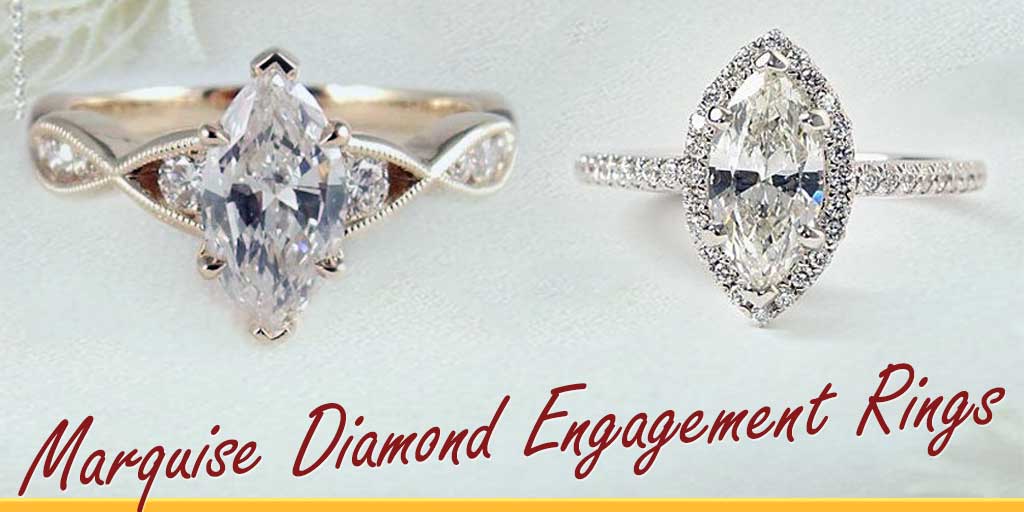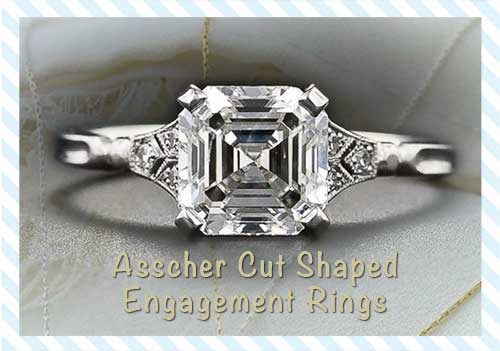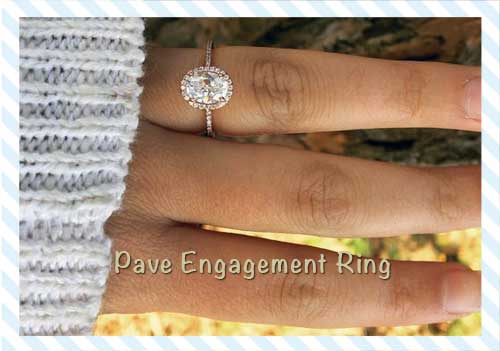Have you heard of the marquise diamond engagement rings? Marquise! What in the world is that? Think France. Marquise refers to a French noblewoman.
Specifically, the ring goes back to the 1700s in France. As the story goes, it was King Louis XIV who had this new shape done to match his mistress’ smile. That’s the short story behind the marquise diamond engagement ring. Well, leaving out any more sordid details . . .
What does it look like?
This ring is all about nobility and sophistication. It goes beyond the traditional round-stone shapes to an oval, narrow look with pointed ends. Someone has compared it to a football. Just envision a football upright on a kicking tee. Maybe that’ll get “his” attention! If you are both football fans then all the better. These diamond’s shapes are also sometimes referred to as boat shapes.

Most jewelers believe that the best proportion for the diamond is a width half the length. And while they do come in different sizes or proportions, when it is particularly thin it creates what is called a bow tie effect. That is, a shadow is created and the center of the diamond looks darker, a bit like a formal bow tie. Some consider this a “flaw” while others see it as part of the uniqueness of the diamond. But you’d want to make sure the cut was done well so that the effect wasn’t too great.
The prong or tiffany setting is most often used for this ring. On the prong setting, two of the prongs, one on each end, keep the stone from chipping. The other two prongs on the long sides hold it in place. What’s called the Bezel setting is also sometimes used. The diamond is secured with a metal rim. It’s made in such a way that it does not affect the appearance of the diamond in a negative way. It looks good and keeps the diamond safe. Though some vintage and antique rings place the diamond parallel to the ring, most are the point the direction of the finger.
Is Marquise Diamond Engagement Ring for you?
If you want a nice ring but not spend a fortune this might be your ring. The shaping of the stone and frequent additions of accenting stones (pear, oval, round) makes the diamond look bigger than it actually is. The additional stones are plus for many couples.
Because of its long shape, if you have long thin fingers this ring would look good on you. And maybe you are one of those who just doesn’t want to be like everybody else. The round diamond is so common some people just want to be different.
Summary:
To review the basics, if you are interested in the marquise diamond engagement ring here are a few points to keep in mind:
- Look for a good cut (of course) but especially with this ring make sure the bow-tie effect is not too pronounced.
- Make sure the setting is such that it will protect the diamond, especially the pointed ends.
- See if it has enough sparkle for you. It won’t be as great as a round cut but it needs to be enough for you.
- Check out the prices. It should be less than the round cuts, but the size of the stone and other factors do affect the final price.
To get a better idea about how the marquise ring looks, there are a few photos placed above. You can also go to a number of websites that offer pictures, prices, reviews, and more.
See the Incredible Marquise Diamond Engagement Rings at Amazon
Marquise Diamond Engagement Rings
Marquise diamond engagement rings — the precision of the marquise cut diamond is vital to its sparkle and brilliance!
Marquise diamond engagement rings vary greatly in price depending on how the diamond in the setting is cut. It is the precision and delicacy of the marquise cut diamond that dictates the maximum amount of light the stone will refract and reflect. Marquise diamond engagement rings (pronounced marKEEYS) also spelled as marquis cut diamonds — are one of the most popular diamond cuts available on the market today. The better the cut, the greater its brilliance and sparkle!

Marquise Diamond Engagement Rings — Check The Cut!
With marquis diamond engagement rings and diamond stones in all rings, the stones are classified into different categories that make it easier to judge the cut, even if you are not a professional. One of the main reasons a marquise cut diamond may be more expensive is because there is a lot of waste discarded from the raw material (or rough) used to get the desired shape which is oval and then pointed on both ends.
When a marquise cut diamond is cut into good proportions, light is internally reflected from one facet to another and then dispersed through the crown. If the cut is too deep, then some light will escape through the opposite side of the pavilion, or bottom of the diamond.
If the marquise cut diamond cut is too shallow, then some light will escape through the pavilion, or bottom, before it can be reflected. So, a well-cut diamond is comprised of facets with the correct angles, which are perfectly placed to maximize the diamond’s brilliance in all of the marquise diamond engagement rings.
Quality vs Carat Weight
When it comes down to buying marquise diamond engagement rings, most consumers have yet to understand that two marquises cut diamonds with the exact same weight, color and clarity can be purchased up to 40% cheaper if the cut is poor. This trade secret allows some jewelers to buy very poor cuts and sell them in turn at prices reserved only for beautifully cut stones.
Marquis diamond engagement rings and diamond stones in all rings are classified into different categories that make it easier to judge the cut, even if you are not a professional.
“Very Good” cut diamonds:
“Very Good” cut diamonds are exceptionally proportioned high-quality stones that reflect back up to 90% of the light entering the diamond.
“Ideal” cut diamonds:
The “ideal” cut diamond refers to the very best of round diamonds.
“Good” cut diamonds:
“Good” rated diamonds are well-cut stones because of their ability to reflect light.
“Fair” or “Poor” cut diamonds:
Diamonds with less than good proportion are rated “fair” or “poor” and are generally less expensive.
It is easier to convince someone to buy a bigger marquise diamond engagement ring than one with a more beautiful marquise cut diamond stone — don’t be fooled!
When cutting a diamond, cutters have to choose between optimizing weight (weight equals money) or optimizing beauty. Sadly, many cutters sacrifice beauty rather than weight. They can get away with this only because stores have been keeping customers in the dark and pushing weight rather than beautiful proportions. It is better to get a “very good” or “good” cut diamond, and end up with a smaller stone, or sacrifice some color or clarity.
Today’s marquise cut diamonds in marquise diamond engagement ring designs are the result of hundreds of years of experience. For example, in the 1920s a Russian mathematician calculated the proportions of the facets in a diamond that would bring an ideal balance between brilliance and dispersion. Any deviation from these designs will compromise the beauty of the stone.

 Asscher Cut Engagement Rings
Asscher Cut Engagement Rings